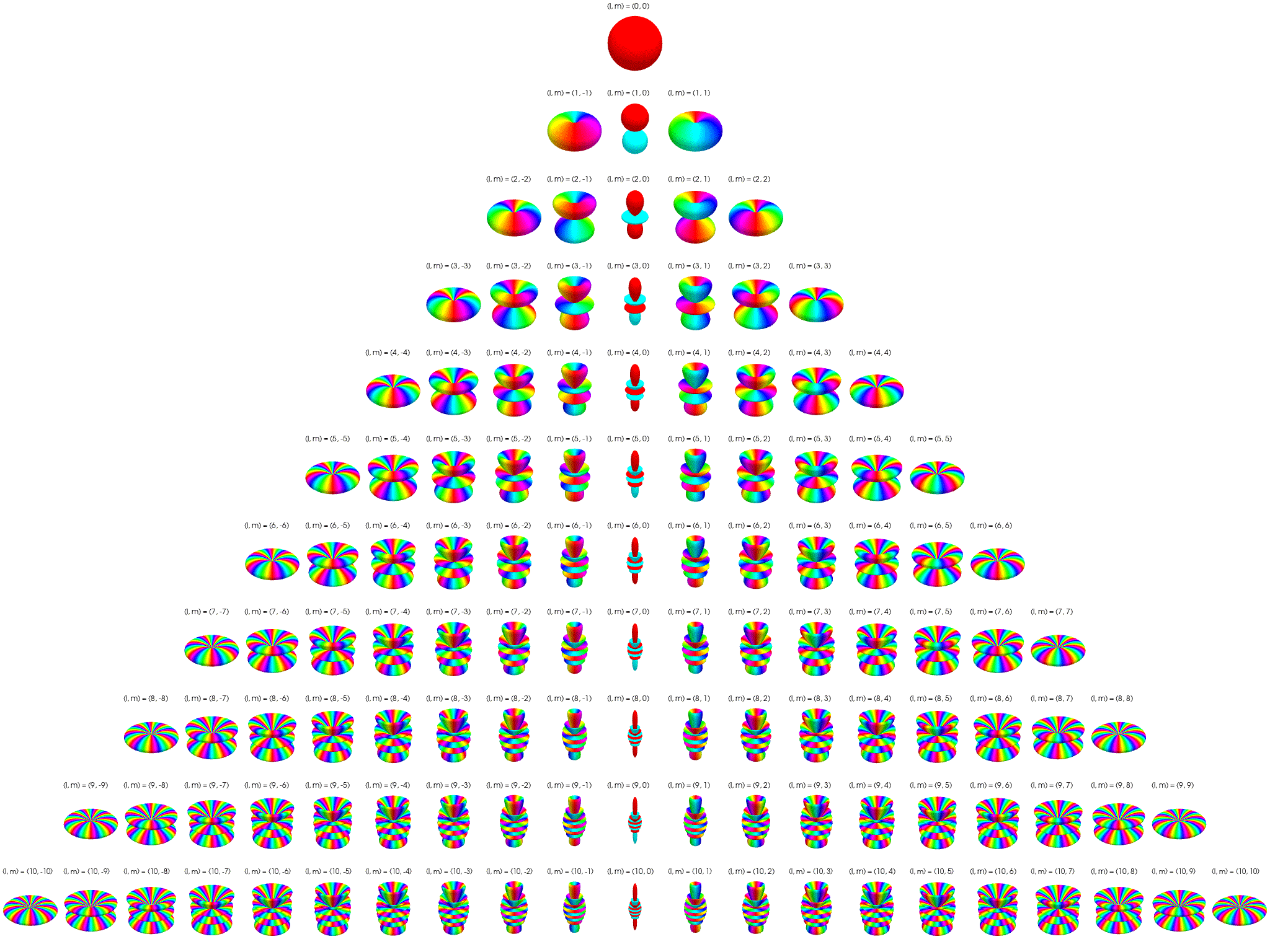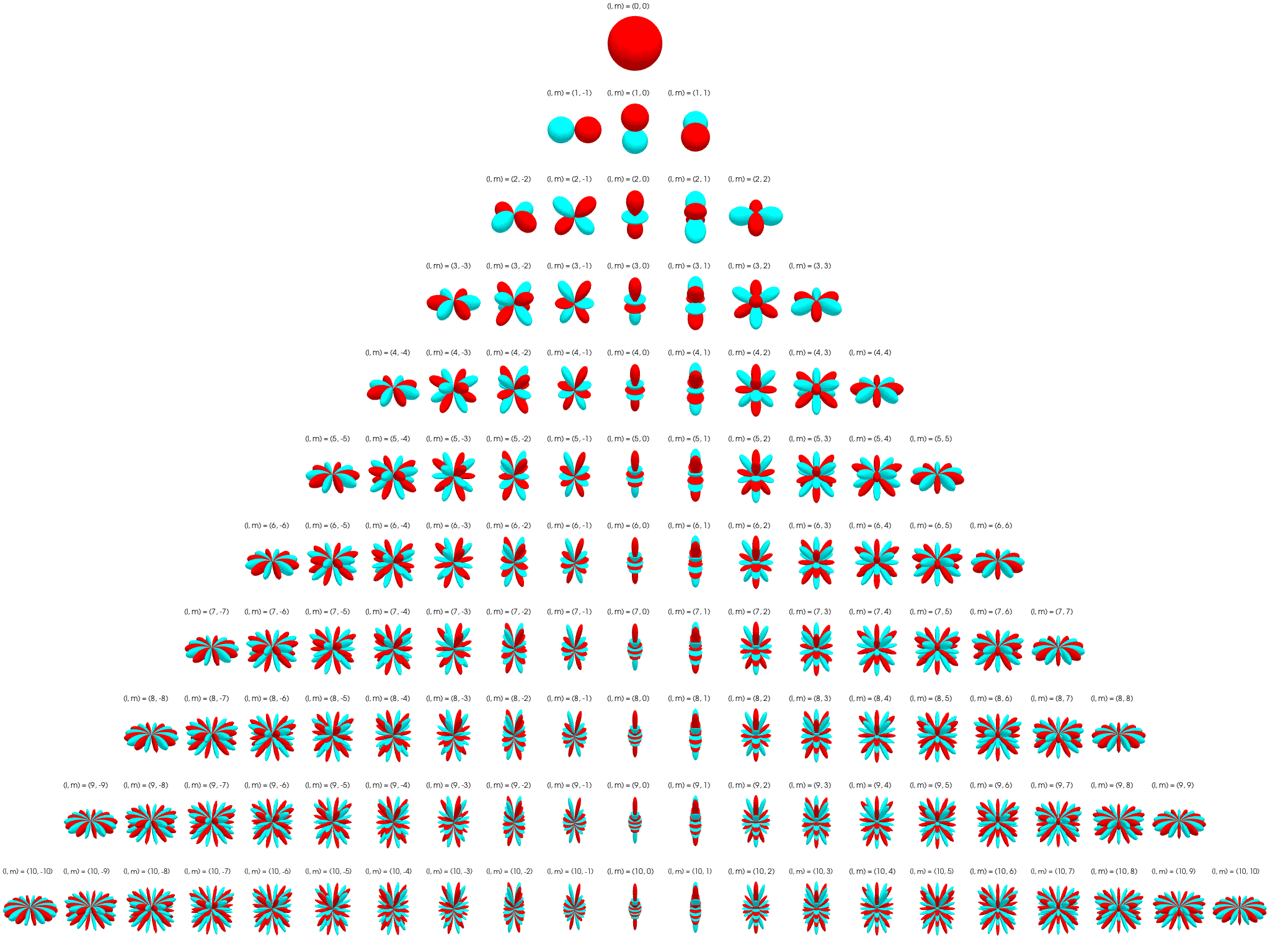This is a table of orthonormalized
spherical harmonics
In mathematics and physical science, spherical harmonics are special functions defined on the surface of a sphere. They are often employed in solving partial differential equations in many scientific fields.
Since the spherical harmonics form a ...
that employ the Condon-Shortley phase up to degree
. Some of these formulas are expressed in terms of the Cartesian expansion of the spherical harmonics into polynomials in ''x'', ''y'', ''z'', and ''r''. For purposes of this table, it is useful to express the usual
spherical to Cartesian transformations that relate these Cartesian components to
and
as
Complex spherical harmonics
For ''ℓ'' = 0, …, 5, see.
''ℓ'' = 0
''ℓ'' = 1
''ℓ'' = 2
''ℓ'' = 3
''ℓ'' = 4
''ℓ'' = 5
''ℓ'' = 6
''ℓ'' = 7
''ℓ'' = 8
''ℓ'' = 9
''ℓ'' = 10
Visualization of complex spherical harmonics
2D polar/azimuthal angle maps
Below the complex spherical harmonics are represented on 2D plots with the azimuthal angle,
, on the horizontal axis and the polar angle,
, on the vertical axis. The saturation of the color at any point represents the magnitude of the spherical harmonic and the hue represents the phase.

Polar plots
Below the complex spherical harmonics are represented on polar plots. The magnitude of the spherical harmonic at particular polar and azimuthal angles is represented by the saturation of the color at that point and the phase is represented by the hue at that point.

Polar plots with magnitude as radius
Below the complex spherical harmonics are represented on polar plots. The magnitude of the spherical harmonic at particular polar and azimuthal angles is represented by the radius of the plot at that point and the phase is represented by the hue at that point.

Real spherical harmonics
For each real spherical harmonic, the corresponding atomic orbital symbol (''s'', ''p'', ''d'', ''f'') is reported as well.
For ''ℓ'' = 0, …, 3, see.
''ℓ'' = 0
''ℓ'' = 1
''ℓ'' = 2
''ℓ'' = 3
''ℓ'' = 4
Visualization of real spherical harmonics
2D polar/azimuthal angle maps
Below the real spherical harmonics are represented on 2D plots with the azimuthal angle,
, on the horizontal axis and the polar angle,
, on the vertical axis. The saturation of the color at any point represents the magnitude of the spherical harmonic and the hue represents the phase.

Polar plots
Below the real spherical harmonics are represented on polar plots. The magnitude of the spherical harmonic at particular polar and azimuthal angles is represented by the saturation of the color at that point and the phase is represented by the hue at that point.

Polar plots with magnitude as radius
Below the real spherical harmonics are represented on polar plots. The magnitude of the spherical harmonic at particular polar and azimuthal angles is represented by the radius of the plot at that point and the phase is represented by the hue at that point.

Polar plots with amplitude as elevation
Below the real spherical harmonics are represented on polar plots. The amplitude of the spherical harmonic (magnitude and sign) at a particular polar and azimuthal angle is represented by the elevation of the plot at that point above or below the surface of a uniform sphere. The magnitude is also represented by the saturation of the color at a given point. The phase is represented by the hue at a given point.

See also
*
Spherical harmonics
In mathematics and physical science, spherical harmonics are special functions defined on the surface of a sphere. They are often employed in solving partial differential equations in many scientific fields.
Since the spherical harmonics form a ...
External links
Spherical Harmonicsat
MathWorld
''MathWorld'' is an online mathematics reference work, created and largely written by Eric W. Weisstein. It is sponsored by and licensed to Wolfram Research, Inc. and was partially funded by the National Science Foundation's National Science ...
Spherical Harmonics 3D representation
References
Cited references
General references
* See section 3 in (see section 3.3)
*For complex spherical harmonics, see als
SphericalHarmonicY[l,m,theta,phi/nowiki> at Wolfram Alpha">,m,theta,phi
">SphericalHarmonicY[l,m,theta,phi
/nowiki> at Wolfram Alpha especially for specific values of l and m.
{{DEFAULTSORT:Table Of Spherical Harmonics
Special hypergeometric functions













